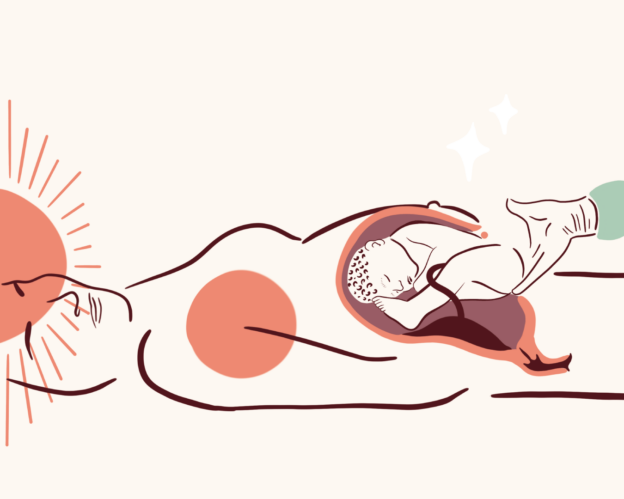Geschreven door Annemieke Verbeek
Gepubliceerd op 20 december 2023
In 2021 beviel wereldwijd één op de vijf (21%) vrouwen met een keizersnede. De WHO verwacht dat dat percentage in 2030 groeit naar ongeveer 29%. De variatie in percentages is enorm; van een paar procent in een aantal Afrikaanse landen tot boven de 50 procent in onder meer Turkije en Brazilië. In Nederland was in 2021 het percentage keizersneden 18,1%, een lichte stijging (0,4%) ten opzichte van het jaar daarvoor (Perined, 2021).
Volgens de WHO zit het kantelpunt tussen voor- en nadelen van het aantal keizersnedes tussen de 10-15%. Onder de 10-15% keizersneden is er mogelijk sprake van een gebrekkige toegang tot noodzakelijke zorg. Boven de 10-15% keizersneden wegen de gezondheidsrisico’s van een keizersnede (op korte, middellang en lange termijn) voor moeder en kind niet op tegen de voordelen.
Dit artikel beschrijft wat een keizersnede is en legt diverse termen uit. Ook kijken we naar wat op dit moment in Nederland de indicaties zijn om te bevallen via een keizersnede, wat de voor- en nadelen van een keizersnede zijn, of een keizersnede op verzoek mogelijk is, hoe het herstel verloopt en hoe vrouwen een keizersnede ervaren. En: is het nodig om het percentage keizersneden laag te houden, en zo ja, wat is daar dan voor nodig?
Alfirevic, Z. et. al (2017), Continuous cardiotocography (CTG) as a form of electronic fetal monitoring (EFM) for fetal assessment during labour, https://www.ncbi.nlm.nih.gov/pmc/articles/PMC6464257/
Ampt, A. et al. (2015), The impact of first birth obstetric anal sphincter injury on the subsequent birth: a population-based linkage study, www.ncbi.nlm.nih.gov/pmc/articles/PMC4339080/
Bates, S. et al. (2012), American College of Chest Physicians.VTE, thrombophilia, antithrombotic therapy, and pregnancy: Antithrombotic Therapy and Prevention of Thrombosis, https://pubmed.ncbi.nlm.nih.gov/22315276/
Besse, M. et al. (2020), Experiences with Achieving Pregnancy and Giving Birth Among Transgender Men: A Narrative Literature Review, https://www.ncbi.nlm.nih.gov/pmc/articles/PMC7513446/
Betran A. et al. (2021), Trends and projections of caesarean section rates: global and regional estimates https://gh.bmj.com/content/6/6/e005671
Bizri, A. et. Al (2021), Timing of term elective cesarean section and adverse neonatal outcomes: A multi-center retrospective cohort study, https://journals.plos.org/plosone/article?id=10.1371/journal.pone.0249557
Blok, H.J. et al, (2020), Perinatale zorg in Nederland anno 2019, Perined https://assets.perined.nl/docs/aeb10614-08b4-4a1c-9045-8af8a2df5c16.pdf
Bloom S et. Al (2006), Leveno KJ, Spong CY, et al. Decision-to-incision times and maternal and infant outcomes. Obstetrics and Gynecology. https://pubmed.ncbi.nlm.nih.gov/16816049/
Bogaert, D. et al. (2023), Mother-infant microbiota transmission and infant microbiota development across multiple body sites, https://www.cell.com/cell-host-microbe/fulltext/S1931-3128(23)00043-4?_returnURL=https%3A%2F%2Flinkinghub.elsevier.com%2Fretrieve%2Fpii%2FS1931312823000434%3Fshowall%3Dtrue
Bonsel, G. et al. (2010), Lijnen in Perinatale sterfte, https://www.erasmusmc-verloskunde.nl/uploads/artikelen/signalementstudie_zwangerschap_en_geboorte_def.pdf
Bohren, M. et al. (2017), Continuous support for women during childbirth, https://www.cochranelibrary.com/cdsr/doi/10.1002/14651858.CD003766.pub6/full
Cahill, A. (2007), Vaginal birth after cesarean delivery: evidence-based practice, https://pubmed.ncbi.nlm.nih.gov/17513937/
Centraal Tuchtcollege voor de Gezondheidszorg. Beslissing in de zaak onder nummer 2002/037. Staatscourant, 3 januari 2003, nr 2, pg 6 https://zoek.officielebekendmakingen.nl/stcrt-2003-2-p6-SC37996.pdf
Cheng, Y. W., Shaffer, B. L., Bryant, A. S., & Caughey, A. B. (2010). Length of the first stage of labor and associated perinatal outcomes in nulliparous women. Obstetrics and gynecology, https://pubmed.ncbi.nlm.nih.gov/20966698/
Cunnington, A. et al. (2016), “Vaginal seeding” of infants born by caesarean section https://www.bmj.com/content/352/bmj.i227
Ekéus, C. (2016), Induced Labor in Sweden, 1999-2012: A Population-Based Cohort Study, https://pubmed.ncbi.nlm.nih.gov/26776817/
Dehue, T. (2023), Ei, foetus, baby, Atlas Contact uitgeverij, ISBN-nummer 9789045039787
Dekker, R. (2012), Evidence on: Skin-To-Skin After Cesarean, evidencebasedbirth.com/the-evidence-for-skin-to-skin-care-after-a-cesarean/
Dijk, M. van (2022), naslagwerk webinar Niet vorderende baring
Eshkoli, T. et al. (2013), Placenta accreta: risk factors, perinatal outcomes, and consequences for subsequent births, https://pubmed.ncbi.nlm.nih.gov/23313722/
Erbaydar, N. (2020), Relationship between caesarean section and breastfeeding: evidence from the 2013 Turkey demographic and health survey, https://bmcpregnancychildbirth.biomedcentral.com/articles/10.1186/s12884-020-2732-6
Federatie Medisch Specialisten (laatste aanpassing 2023), Beleid bij sectio in voorgeschiedenis, richtlijnendatabase.nl/richtlijn/beleid_bij_sectio_in_de_voorgeschiedenis/startpagina_-_beleid_bij_sectio_in_voorgeschiedenis.html
Federatie Medisch Specialisten (2010), Sectio caesarea bij extreme vroeggeboorte, richtlijnendatabase.nl/richtlijn/perinataal_beleid_bij_extreme_vroeggeboorte/sectio_caesarea_bij_extreme_vroeggeboorte.html
Federatie Medisch Specialisten (2018), Beleid rondom spoedoperaties, timing bij ongeplande sectio’s, https://richtlijnendatabase.nl/richtlijn/beleid_rondom_spoedoperaties/timing_bij_ongeplande_sectios.html
Fuglenes, D. et al. (2010), Norwegian obstetricians' opinions about cesarean section on maternal request: should women pay themselves? https://pubmed.ncbi.nlm.nih.gov/20925586/
Hourigan, S. et al. (2022), Can maternal-child microbial seeding interventions improve the health of infants delivered by Cesarean section?, www.ncbi.nlm.nih.gov/pmc/articles/PMC9237654/
Gangwar, R. (2016), Caesarean Section for Foetal Distress and Correlation with Perinatal Outcome, https://www.ncbi.nlm.nih.gov/pmc/articles/PMC5016439/
Gedefaw, G. et al. (2020) Effect of cesarean section on initiation of breast feeding: Findings from 2016 Ethiopian Demographic and Health Survey, https://journals.plos.org/plosone/article?id=10.1371/journal.pone.0244229 Grobman, W. et al. (2018), Labor Induction versus Expectant Management in Low-Risk Nulliparous Women, https://pubmed.ncbi.nlm.nih.gov/30089070/ Guise J.M. et. al (2010), Vaginal Birth After Cesarean: New Insights, www.ncbi.nlm.nih.gov/books/NBK44571/ Heitmeijer, E.S.E. (2020) et al, Intrapartum epidural analgesia and emergency delivery for presumed fetal compromise: association or causation? Hypothesized mechanism explored, https://pubmed.ncbi.nlm.nih.gov/37910798/ Hollander, M. et al (2017), Preventing traumatic childbirth experiences: 2192 women's perceptions and views, https://pubmed.ncbi.nlm.nih.gov/28553692/ Hovius, R. (2023), ‘Ei, foetus, baby’ laat zien hoe machteloos zwangere vrouwen eeuwenlang waren, met gruwelijke gevolgen, De Volkskrant 20 qpril 2023, https://www.volkskrant.nl/boeken/ei-foetus-baby-laat-zien-hoe-machteloos-zwangere-vrouwen-eeuwenlang-waren-met-gruwelijke-gevolgen~ba7a2899/?referrer=https://www.google.com/ Fransiscus Gasthuis Rotterdam (2023), patiëntenfolder De Keizersnede, https://www.franciscus.nl/uploads/2023-05/De%20keizersnede.pdf Gurewitsch, E. (2007), Shoulder Dystocia, https://www.sciencedirect.com/science/article/abs/pii/S0095510807000371?via%3Dihub
-
Kallianidis, A. (2022), Maternal mortality after cesarean section in the Netherlands, https://www.ejog.org/article/S0301-2115(18)30954-0/fulltext
Karakaya, I. et al. (2012) Effects of physiotherapy on pain and functional activities after cesarean delivery, www.pubmed.ncbi.nlm.nih.gov/21830007/ Keag, O. et al. (2018), Long-term risks and benefits associated with cesarean delivery for mother, baby, and subsequent pregnancies: Systematic review and meta-analysis, https://journals.plos.org/plosmedicine/article?id=10.1371/journal.pmed.1002494 Klaus, M. H., Kennell J.H., The doula: an essential ingredient of childbirth rediscovered https://onlinelibrary.wiley.com/doi/abs/10.1111/j.1651-2227.1997.tb14800.x?sid=nlm%3Apubmed Klein Meuleman, J.M. et al. (2023), Definition and Criteria for Diagnosing Cesarean Scar Disorder, jamanetwork.com/journals/jamanetworkopen/fullarticle/2802847?utm_campaign=articlePDF&utm_medium=articlePDFlink&utm_source=articlePDF&utm_content=jamanetworkopen.2023.5321 Kulshrestha, V. et al. (2020), Post-caesarean Niche (Isthmocele) in Uterine Scar: An Update, https://www.ncbi.nlm.nih.gov/pmc/articles/PMC7758379/ Kwee, A. et. al (2007), Obstetric management and outcome of pregnancy in women with a history of caesarean section in the Netherlands, www.ejog.org/article/S0301-2115(06)00393-9/fulltext Landon, M. B. et. al (2006), Risk of uterine rupture with a trial of labor in women with multiple and single prior cesarean delivery. Obstetrics & Gynecology, 108(1), pp.12-20. https://doi.org/10.1097/01.AOG.0000224694.32531.f3 Li, L. et al. (2021), Breastfeeding after a cesarean section: A literature review, https://pubmed.ncbi.nlm.nih.gov/34425257/ Lettink, A. et al. (2020), CCT: continuous care trial - a randomized controlled trial of the provision of continuous care during labor by maternity care assistants in the Netherlands, https://bmcpregnancychildbirth.biomedcentral.com/articles/10.1186/s12884-020-03336-6 Maassen, M. et al. (2008), Operative deliveries in low-risk pregnancies in The Netherlands: primary versus secondary care, https://pubmed.ncbi.nlm.nih.gov/19036039/ March of dimes Peristat, data for unted states (laatste update 2022), https://worldpopulationreview.com/country-rankings/c-section-rates-by-country
Millicent Anim, S. (2011), Epidural versus non-epidural or no analgesia in labour, https://pubmed.ncbi.nlm.nih.gov/22161362/
Meriç, M. (2019) Women’s Experience of Cesarean Section: A Qualitative Study https://www.researchgate.net/publication/335878703_Women%27s_Experience_of_Cesarean_Section_A_Qualitative_Study
Mylonas, I. (2015), Indications for and Risks of Elective Cesarean Section, https://www.ncbi.nlm.nih.gov/pmc/articles/PMC4555060/
National /insitute for Health and Care Excellence (NICE), guideline (2021), Caesarean birth, https://www.nice.org.uk/guidance/ng192
Nederlandse Vereniging voor anesthesiologie, Keizersnede: wat voor verdoving krijg je?, https://www.anesthesiologie.nl/patient-publiek/pijn-en-bevalling/bevallen-met-een-keizersnede
Nederlandse Vereniging voor Obstetrie en Gynaecologie/NVOG (2008), richtlijn Bloedverlies in de tweede helft van de zwangerschap, https://richtlijnendatabase.nl/gerelateerde_documenten/f/12178/Richtlijn%20-%20Bloedverlies%20in%20de%20tweede%20helft%20zwangerschap.pdf
Nederlandse Vereniging voor Obstetrie en Gynaecologie/NVOG (2011), Indicatiestelling sectio caesare, https://richtlijnendatabase.nl/gerelateerde_documenten/f/12184/Indicatiestelling%20sectio%20caesarea.pdf
Nederlandse Vereniging voor Obstetrie en Gynaecologie/NVOG (2013), richtlijn Totaalruptuur, https://www.mdl.nl/sites/www.mdl.nl/files/richlijnen/definitief_richtlijn_totaalruptuur__2013_website.pdf
Nieuwenhuis, M. (2020) Baby’s lopen snijwonden op bij keizersnedes: ‘Geraakt, en nog diep ook’ https://www.ad.nl/binnenland/babys-lopen-snijwonden-op-bij-keizersnedes-geraakt-en-nog-diep-ook~a33d8724/
Offerhaus, P. et al. (2023), Regional practice variation in induction of labor in the Netherlands: Does it matter? A multilevel analysis of the association between induction rates and perinatal and maternal outcomes, https://journals.plos.org/plosone/article?id=10.1371/journal.pone.0286863
Patiëntenfederatie Nederland (2021), rapport: Ervaringen van vrouwen met een keizersnede, https://www.patientenfederatie.nl/downloads/rapporten/785-ervaringen-van-vrouwen-met-een-keizersnede/file
Perined jaarboek 2018 (2019 gepubliceerd), https://assets.perined.nl/docs/fc23b860-a5ff-4ef6-b164-aedf7881cbe3.pdf
Piua, D. (2018) First-Time Mothers’ Experiences of a Planned Cesarean Birth, https://www.ncbi.nlm.nih.gov/pmc/articles/PMC6386785/
Sandall, J. (2018), Short-term and long-term effects of caesarean section on the health of women and children, https://pubmed.ncbi.nlm.nih.gov/30322585/
Sargent, J. et. al (2015), Outcomes following uterine rupture during a trial of labor after cesarean: A 2012-2015 national cohort. www.ajog.org/article/S0002-9378(17)31567-3/...
Schneider, L. et al. (2017), Influence of Immediate Skin-to-Skin Contact During Cesarean Surgery on Rate of Transfer of Newborns to NICU for Observation, pubmed.ncbi.nlm.nih.gov/28187837/
Signore, C. (2008) Neonatal Morbidity and Mortality After Elective Cesarean Delivery, https://www.ncbi.nlm.nih.gov/pmc/articles/PMC2475575/
Słabuszewska-Jóźwiak, A. et al (2020) ,Pediatrics Consequences of Caesarean Section—A Systematic Review and Meta-Analysis, https://www.ncbi.nlm.nih.gov/pmc/articles/PMC7662709/
Small, K. et. al (2020), Intrapartum cardiotocograph monitoring and perinatal outcomes for women at risk: Literature review, https://pubmed.ncbi.nlm.nih.gov/31668871/
Sohby, S. et al. (2019), Maternal and perinatal mortality and complications associated with caesarean section in low-income and middle-income countries: a systematic review and meta-analysis, https://pubmed.ncbi.nlm.nih.gov/30929893
Stone, J. et al. (2022) “Physical Therapy in Addition to Standard of Care Improves Patient Satisfaction and Recovery Post-Cesarean Section,
Sütcü, E. (2023) Waarom heet een keizersnede zo?, https://historianet.nl/wetenschap/geneeskunde/waarom-heet-een-keizersnede-zo
Suwanrath, C., Why do pregnant women prefer cesarean birth? A qualitative study in a tertiary care center in Southern Thailand, https://bmcpregnancychildbirth.biomedcentral.com/articles/10.1186/s12884-020-03525-3
Royal College of Obstetricians and Gynaecologists (RCOG, 2015), Birth After Previous Caesarean Birth, www.rcog.org.uk/media/kpkjwd5h/gtg_45.pdf
Royal College of Obstetricians & Gynaecologists (RCOG), patiëntenfolder Schouderdystocie, https://www.rcog.org.uk/for-the-public/browse-our-patient-information/shoulder-dystocia-patient-information-leaflet/
Tita, A. et. Al (2009), Timing of elective repeat cesarean delivery at term and neonatal outcomes, https://pubmed.ncbi.nlm.nih.gov/19129525/
U.S. National Library of Medicine (laatste update 2011), Cesarean Section - A Brief History https://www.nlm.nih.gov/exhibition/cesarean/preface.html
Veringa-Skiba, I.K. (2021) Fear of childbirth, nonurgent obstetric interventions, and newborn outcomes: A randomized controlled trial comparing mindfulness-based childbirth and parenting with enhanced care as usual, https://onlinelibrary.wiley.com/doi/10.1111/birt.12571
Wilmink F. et. Al (2010), Neonatal outcome following elective cesarean section beyond 37 weeks of gestation: a 7-year retrospective analysis of a national registry, https://pubmed.ncbi.nlm.nih.gov/20207243/
World Populationreview, C-Section Rates by Country 2023, https://worldpopulationreview.com/country-rankings/c-section-rates-by-country
Yang, Q. et al. (2007), Association of caesarean delivery for first birth with placenta praevia and placental abruption in second pregnancy, https://pubmed.ncbi.nlm.nih.gov/17355267/
Young, C. B. et. al (2018), Mode of delivery after a previous cesarean birth, and associated maternal and neonatal morbidity, www.pubmed.ncbi.nlm.nih.gov/29735533/




Reacties